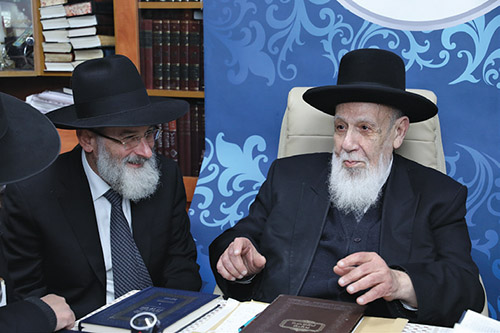
The simple home of HaGaon HaRav Gershon Edelstein, shlita, venerated senior rosh yeshiva of Ponevezh, is not usually a venue for public celebrations. The Rosh Yeshiva is well known for the privacy he maintains and for eschewing the public spotlight. Nevertheless, for every rule there is an exception. Recently, with the completion of hilchos Shabbos in the Dirshu Daf HaYomi B’Halacha cycle, Rav Gershon not only agreed to host a siyum in his apartment but he went out of his way to address the siyum and give guidance to the wider community on the importance of learning practical halacha on a regular basis.
Without a doubt, the highlight of the event were the words of the nonagenarian senior rosh yeshiva, Rav Gershon.
“There is no need to give divrei bracha at such an event, because the bracha has already been promised by Chazal, who teach, ‘He who learns halacha every day is assured a place in Olam Habaah, [Niddah 76].’ Thus, the bracha is assured.”
The home of the Sanzer Rebbe is no stranger to Dirshu. The Rebbe has been an enthusiastic supporter of Dirshu from its inception.
In his remarks, the Sanzer Rebbe quoted the Shulchan Aruch Harav in Hilchos Talmud Torah that says, “’A person who is not able to learn all day should learn the halachos that are relevant for him to know in the course of his daily life.’ A Yid must know halacha; if not, he cannot conduct himself as a Yid,” the Rebbe said. “The minimum is learning Kitzur Shulchan Aruch, but certainly, learning Mishnah Berurah is better.”
Rav Dovid Hofstedter said that before Yaakov Avinu went down to Egypt with his family he sent his son Yehuda ahead of him. Why? The Midrash states that Yehuda went first in order to open a beit talmud, a yeshiva, from where Torah rulings would come forth. The Midrash is telling us two things: There is a yeshiva, but there is also the additional component of a place from where Torah rulings will emanate. Any new place to where Jews come, our sages are telling us, must first have both a yeshiva and a place where one can receive halachic rulings and halachic guidance from our sages.
“Why,” Rav Hofstedter asked, “did Yaakov Avinu specifically send Yehuda? If he wanted to build a yeshiva he should have perhaps sent an architect and a developer. The answer,” he posited, “is that Yehuda is the power of malchus, the power of a king. Whenever there is something good happening, the satan, the yetzer hara, tries to get in the way. Yehuda has the power of malchus, a power that can counter the yetzer hara’s diabolical plans.”
There was also a siyum at the home of HaGaon Hacham Shalom Cohen, shita, rosh yeshiva of Yeshiva Porat Yosef. “Some might say that the Mishnah Berurah is a sefer written for Ashkenazim, not for Sephardim. After all, we rule in accordance with Maran, the Bet Yosef, and they rule in accordance with the Rema. What then,” Rav Shalom asked, “would be the point of learning the Mishnah Berurah when its laws are not written in accordance with the Sephardic halachic rulings?”
He answered, “When one learns the Mishnah Berurah, one can truly understand the underlying premise of the halachah. I always tell my talmidim that although we Sephardim do not rule like the Mishnah Berurah, they should first learn the Mishnah Berurah and then learn the final outcome of the Sephardic poskim. After all, the Mishnah Berurah teaches you how to understand the halacha, not just what the halacha is.
At the siyum on Chelek Gimmel held at the Dirshu Convention in Stamford, Connecticut, a few weeks ago, Rav Gershon Edelstein expressed his joy over the fact that they were celebrating the completion of Chelek Gimel and beginning Chelek Daled of Mishnah Berurah.
When Rav Gershon was told about the multitudes of lomdei Dirshu who will be completing Shas next year with bechinos and that Dirshu would celebrate their accomplishments with massive siyumim in Eretz Yisrael, England, France and South Africa, culminating in an enormous siyum at the Prudential Center in Newark, New Jersey, in mid-February 2020, the Rosh Yeshiva expressed his great joy. He pointed out that when a large public siyum is made, it encourages more people to learn. He brought proof to this concept from a pasuk in Mishlei (1:20), “Wisdom sings out in the streets; it gives forth its voice in public.” Rav Edelstein explained, “When wisdom is being praised in the street it gives forth a voice in public that influences others.”
When asked to give a bracha in honor of next year’s Siyum HaShas, the Rosh Yeshiva answered, “The bracha is min hashamayim! Hashem blesses those who learn Torah. My bracha is that you should have siyata dishmaya in everything that you do!”
By Chaim Gold










